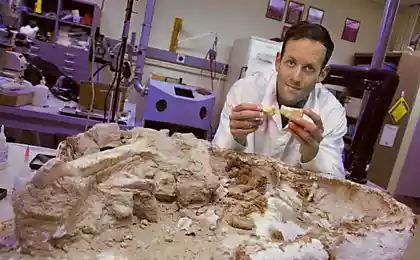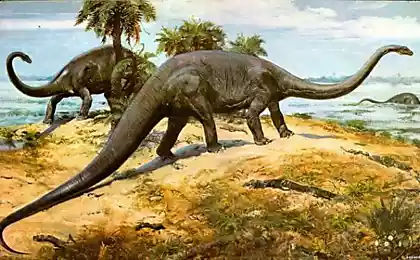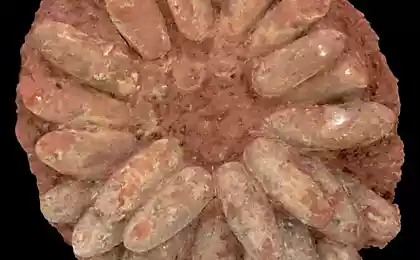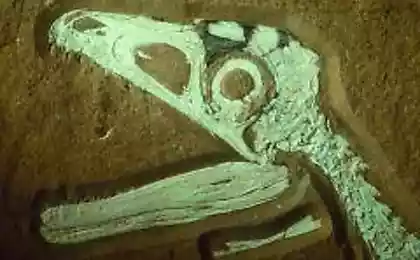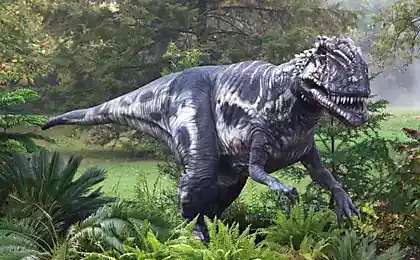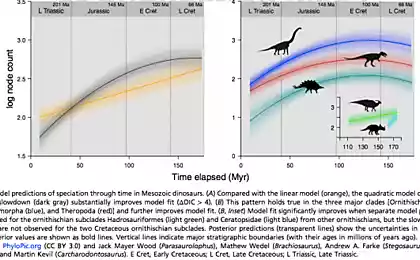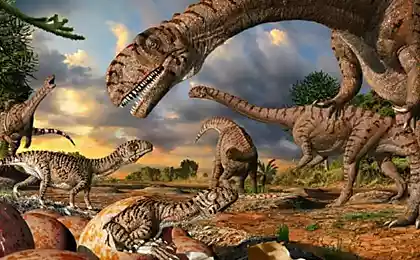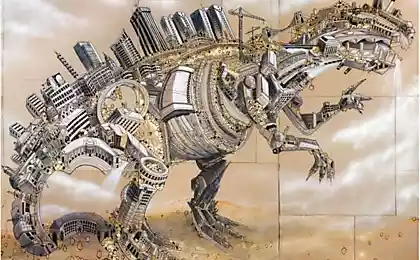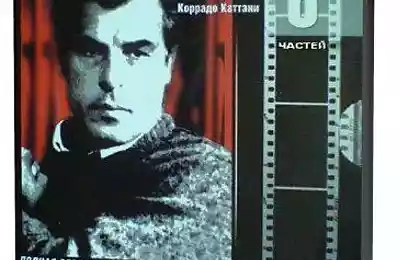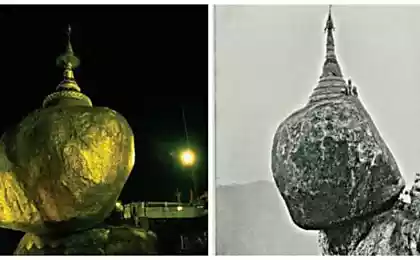2109
Dinosaurs
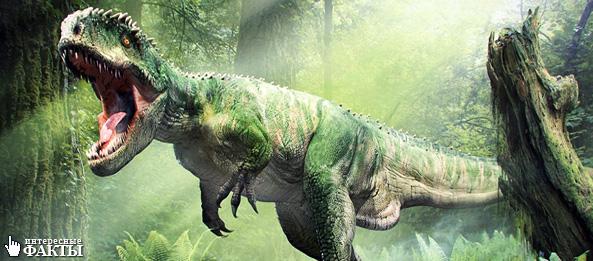
When there were dinosaurs?
Documented evidence of the appearance of the dinosaurs about two hundred and forty million years ago. If the history of the Earth compress up to 1 year, assuming that the birth of the Earth occurred on 1 January, the first life appeared no earlier than the end of March. The first dinosaurs appeared to mid-December. The first people appeared to only a few hours before the end of the year.
How many animals become extinct?
More than 99, 9 per cent of the animals who ever lived on Earth are extinct before man.
Ancient reptiles.
Unmarked (insectivorous) (1972) was found in Kentucky, United States, its estimated age of 310 million years.
Dinosaurs of the Mesozoic era.
Development of the Earth is divided into five periods, which are called eras. The first two eras, Archeozoic and Proterozoic lasted 4 billion years, nearly 80% of the earth's history. Arheozoya occurred during formation of the Earth, having the water and oxygen. About 3, 5 billion years ago, the first tiny bacteria and algae. In the era of the Proterozoic, about 700 years ago in the sea were the first animals. They were primitive creatures invertebrates, such as worms and jellyfish.
Paleozoic era began 590 million years ago and lasted 342 million years. Then the land was covered with swamps. During the Paleozoic there were large plants, fish and amphibians. The Mesozoic era began 248 million years ago and dlilas183 million years. At this time, the Earth was inhabited by huge dinosaurs dinosaurs. There were also the first mammals and birds. Cenozoic era began 65 million years ago and is still going on. At this time any plants and animals that surround us today.
The most primitive dinosaur ...
... Considered Eoraptor lunensis. He was given this name in 1993, when in the foothills of the Andes in Argentina, in the rocks, whose age is 228 million. Years old, was found by his skeleton. The body length of this dinosaur was 1 m. He was carried to the theropod (carnivorous dinosaurs of the order ornithischian).
The life span of the dinosaurs.
Most dinosaurs lived over a hundred years.
Most large animals.
The dinosaurs were the largest animals in the history of the Earth. One of the largest dinosaurs was Supersaurus Supersaurus. It weighed as much as 10 elephants. Huge size reached herbivorous dinosaurs. Particularly large, up to 30 meters in length, were Brachiosaurus and Diplodocus. Sauropods - the representatives of the suborder Saurischia dinosaurs differed long neck, long tail and moves on four legs. These herbivorous dinosaurs inhabited most of the land in the Jurassic and Cretaceous, 208-65 million. Years ago.
Diplodocus.
Diplodocus, who lived in the Cretaceous period, had a body length of more than 25 m; he lived in North America.
Dinosaurs had five fingers.
The inhabitants of the land tetrapods, four-legged amphibians were about five toes on each foot, and loved to walk on the sand of the ancient coastal seas and oceans. Here are some traces of age from 360 to 345 million years and were recently discovered in eastern Canada - the oldest known to date.
Most ridiculous dinosaur - Therizinosaurus.
In Therizinosaurus legs were like birds, muzzle ended toothless beak, on each paw was four functional finger.
The heaviest dinosaurs ...
... Were probably: Titanosaurs Antarctosaurus giganteus (Giant Antarctic lizard), weighed 40-80 tons, the fossils are found in India and Argentina; Brachiosaurus Brachiosaurus altithorax (rukoyascher), so named for their long forelimbs (45-55 m); Diplodocus Seismosaurus halli (pangolin, earth-shattering) and Supersaurus vivianae (both weight exceeding 50 tons, and according to some estimates close to 100 tons). Estimated weight of the Argentine titanosaur - Argentinosaurus - up to 100 tonnes. Estimates made in 1994, were based on the size of its giant vertebrae.
Armored dinosaurs.
Ankylosaurs - most of the armored dinosaurs. Back and head they were protected by bony plates, horns and spikes. Trunk reaches a width of 2, 5 m. The hallmark was a big club, which ends tail.
Highest dinosaur.
The tallest and largest species of dinosaur skeleton is preserved completely, was Brachiosaurus Brachiosaurus brancai, found in Tedaguru, Tanzania. It was discovered in the late Jurassic sediments (150 -144 000 000. Years ago). The total length of Brachiosaurus was 22, 2 m; withers height - 6 m; height with lifted head - 14 m. Probably, during the life of the weight of a dinosaur was 30 - 40 m. However, fibula other Brachiosaurus stored in the museum, which suggests that these animals were even larger.
The longest dinosaur ...
... It Brachiosaurus. Footprints suggest that the length of the body Brachiosaurus Breviparopus reached 48 m. Diplodocus Seismosaurus halli, found in 1994 in the piece. New Mexico, United States, reaches a length of 39-52 m. These estimates are based on a comparison of the bones.
Iguanodon.
Iguanodon, who lived in the Cretaceous period, had a body length of about 10 m; he lived in Western Europe, North Africa, Mongolia; was a herbivore.
The smallest dinosaurs.
The smallest dinosaurs were the size of a chicken. Length dwelled in southern Germany and south-eastern France kosmognatusa (trans. Graceful jaw) and poorly known herbivorous fabrozavra of the piece. Colorado, USA, from tip of nose to tip of tail is 70-75 cm. The first weighed about 3 kg, and the second - 6, 8 kg.
The largest skull ...
... Belongs Torosaurus. This herbivorous lizard, worn around the neck of a giant bone shield, was a length of about 7, 6 meters and weighed up to 8 tons. The length of the skull, with bone frill, reached 3m and weighs 2 tons. He lived on the territory of present states of Montana and Texas, United States.
Stegosaurus.
Stegosaurus, who lived in the Cretaceous period, had a body length of about 9 m; was a herbivore.
The biggest tracks were in ...
... Hadrosaur (duck-billed platypus). They were discovered in 1932 in Salt Lake City, NY. Utah, This large dinosaur moved on its hind legs. The length of its tracks 136 cm, and the width of -81 cm. Other reports from Colorado and Utah say the following, the width of which reaches 95-100 cm. The width of the tracks, apparently hindlimb biggest Brachiosaurus up to 100 cm.
Triceratops.
Triceratops - a reptile that looks like a rhinoceros lived in the Cretaceous period, had a body length of about 7 m; he lived in North America; was a herbivore.
Most toothy dinosaur ...
... It ornithomimids. In birdlike dinosaur Pelecanimimus was more than 220 very sharp teeth.
Most long claws ...
... Belong Therizinosaurus found in Nemegt Basin, Mongolia, in the Late Cretaceous sediments. Their length is reached for the outer curvature of 91 cm (compared with 20 cm for 3 Tyrannosaurus rex). This dinosaur was fragile skull and had no teeth. He ate probably termites. The second bidder - a Spinosaurus. In January 1983, an amateur paleontologist William Walker, near Dorking, c. Surrey, England, was found claw length of 30 cm. It is assumed that it belonged Spinosaurus whose total length is greater than 9 meters, the approximate weight was 2 m.
Speed of movement.
Dinosaur trail can be used to evaluate their speed. One trail, discovered in 1981 on the territory of the pieces. Texas, United States, leads to the conclusion that a carnivorous dinosaur could move at a speed of 40 km / h. Some ornithomimids ran even faster. For example, who had a big brain 100-pound Dromiceiomimus, inhabiting the territory of present pr. Of Alberta, Canada, at the end of the Cretaceous period, could probably outrun an ostrich, which can reach speeds of over 60 km / h.
Herbivorous lizard with a hole in the skull.
A new type of dinosaur bones Suuwassea emilieae been excavated in Montana in 1999 and 2000. This herbivorous dinosaurs 150 million years. He is a relative of the well-known Diplodocus. The length of the animal was 15 meters. He had a long neck and tail like a whip, and a mysterious extra hole in the skull. Its purpose is unknown. And a similar extra hole before scientists found just two species of dinosaur found in South America and Africa.
The most quick-witted dinosaur.
In flightless dinosaurs - Troodontidae brain mass in relation to body weight was such that perhaps this dinosaurs were the most intelligent, the same as the most intelligent birds.
The brain of a walnut.
Stegosaurus in length is 9 meters, but his brain weighed 50 - 70 g was just the size of a walnut. It was 0, 002% of the weight of his body, is equal to an estimated 3, 3 vol. Stegosaurus lived about 150 million. Years ago on the territory of present states of Colorado, Oklahoma, Utah and Wyoming.
Plesiosaur.
Plesiosaur - a sea animal with a long neck, who lived in the Cretaceous period, had a body length of 16 m; he lived in Europe, North America; lived in the sea; was carnivorous and feed on fish and marine invertebrates.
Predators were smaller.
Dinosaurs predators were smaller and moved on the hind legs. The biggest of these was the tyrannosaurus, height 5-6 meters and 12 meters long. His mouth was a length of 1 m. In one sitting, he could swallow prey weighing 200 kg. Tyrannosaurs - the worst land predators in the history of the planet. Adults weighed about 5.6 tons, and thus were 15 times heavier than the largest modern predator - the polar bear. Dinosaur roamed the Earth 65 million years ago, was the largest land predator of all time.
How many years have lived tyrannosaurs?
Tyrannosaurs - the worst land predators in the history of the planet - died young. Predator has grown rapidly, gaining two kilograms per day, as a modern African elephant. How they managed to grow to such a size? Some experts believe that they slowly grew all their lives, others - that they are rapidly growing in his youth, and then the rate of increase slowed sizes, as in birds and mammals. that all these creatures at the time of death was between two and 28 years. Animals grew most strongly in the 14-18-th years of his life, further supporting reached sizes.
Feathered Tyrannosaurus.
The ancestors of T. rex were covered with small feathers, rather than bare skin. The skeleton of an ancestor, age about 130 million years old, is the oldest member of the genus tyrannosaurs, and so far the only one whose "feathered" no doubt paleontologists. He was somewhere half meters from nose to tail. However, he went on his hind legs and was a formidable predator - for smaller herbivorous dinosaurs. Tyrannosaurus itself was hardly covered with feathers - it they would be more hindrance than help, because of the large size it was more important to give to the world the excess heat so as not to overheat. However, his "chicks" could hatch from eggs covered with an analog of fluff, and lose it as they grow older Procrastinators predators
The largest predator in the world of dinosaurs, probably was pretty slow.
Tyrannosaur rex could not accelerate to a speed of 40 km / h, although many scientists believe that he was able to be worn almost twice as fast. Their findings, scientists have made on the basis of a computer model of six-ton lizard.
What eats tyrannosaurs?
Dimensions tyrannosaurs were problems for these animals - becoming more they are likely to gradually lose the ability to move quickly. Young small animals could reach a speed of 40 kilometers per hour, but once the weight was becoming more than a ton, it became impossible for biomechanical reasons. So if this animal was a predator and not a scavenger, it is a mystery how he managed to produce enough food to support a huge growth rate of the body. Perhaps ecosystem Jurassic produce enough to fall - and Tyrannosaurus just did not need to actively hunt. Fell around was enough. And it is unclear whether tyrannosaurs predators or eat mostly carrion?
Tyrannosaurus.
Tyrannosaurus, who lived in the Cretaceous period, had a body length of about 14 m; he lived in Asia, North America; this is the largest ever existing carnivorous land animal.
Chetyrehkryly lizard.
In the north-east of China lived chetyrehkryly dinosaur Microraptor gui. It is assumed that he could make short planning flights from tree to tree. Its length from head to tail is only 77 cm, but it is considered the rarest of all ever discovered dinosaur species. One of the most valuable finds are the remains chetyrehkrylogo carnivorous dinosaur, called "Microraptor gui", which were discovered last year in the Chinese province of Liaoning. According to scientists, this kind of dinosaur is the last missing link in the evolutionary picture of the transformation of dinosaurs into birds.
Powerful bite.
Tyrannosaurus not just bruised his teeth into the victim's body, as it is done today, say, lions. He is quick and easy to bite through a greater depth muscle, cartilage, and even a thick bones, and then tore out large chunks of flesh of the victim. Bones were milled in food with meat. Tyrannosaurus had a very strong skull and jaw. And the most amazing thing is that the monster was also a whole system of depreciation shock. In particular, unlike most of the animals of the bones constituting the skull tirannozavra maintained at a certain mobility relative to each other. Connective tissue helps to dissipate impact energy. Of course, this way of eating Tyrannosaurus rex and helped his sharp 15-centimeter teeth.
As breathing dinosaur?
About how was the effective volume of the lungs in minerals, can be seen by studying the joints between the spine and the ribs of the animal. The ancient forms of the respiratory system was much weaker than, for example, T. rex and other living near the end of the Jurassic period. Thorax The latter has a better ability to expand. Early dinosaurs in North America were able to per unit of time to absorb forty percent less air than later, lived after the middle of the Jurassic period. As for the dinosaurs of South America, they have similar development occurred much later.
Hunting northern strategy dinosaurs.
There is an assumption that "northerners" resorted to "patrol" of large areas, and then pursued their prey over a very long distance. This hypothesis is based on the study of the thorax predators makes it easy to absorb large volumes of air.
The largest eggs ...
... Titanosaurs postponed. Hypselosaurus priscus, 12-meter Titanosaurs, who lived about 73-65 million. Years (according to some sources - 80 million. S) ago. Shards of dinosaur eggs were found in October 1961 in the valley of the Durance, France. One can assume that his overall dimensions were 30 cm in length and 25 cm in diameter, five (capacitance - 3, 3 L). Titanosaurs himself weighed about 10 tons.
The biggest egg ever deferred living creature belongs to an extinct Aepiornisu Madagascar. Egg had a length of 24 cm and a volume of 11 liters.
